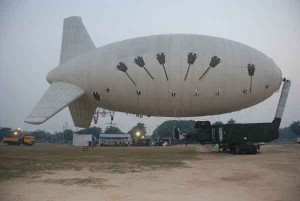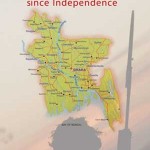Air or Aerospace Defence provides a secure foundation for the safe and effective launch of aircraft and missiles to tackle an airborne or space-based intruder. Besides, the sharp end comprising aircraft, missiles and air defence guns, the first to detect intruders are the radars. The radars, along with an efficient Command, Control and Communication system, form a comprehensive Air Defence Network. Is the surveillance network in the Indian airspace gap-free? Is there adequate overlap between low, medium and high levels of radar coverage?
It is the eyes and ears of the Air Defence of a nation that will first detect, validate, launch and then guide the various weapons, aircraft, missiles and anti-aircraft guns to destroy an intruder. In 2008, a report by the CAG on the preparedness of the Indian Air Force (IAF) observed, “Air defence is critical to the nation’s security yet the IAF holds less than the adequate number of surveillance radars needed for efficient and reliable detection capabilities for a credible air defence system.” An in-depth analysis of India’s Air Defence Ground Environment System (ADGES) had also revealed that the number and type of radars with the IAF were not adequate to provide coverage to the entire country.
Air or Aerospace Defence provides a secure foundation for the safe and effective launch of aircraft and missiles to tackle an airborne or space-based intruder. Besides, the sharp end comprising aircraft, missiles and air defence guns, the first to detect intruders are the radars. These, along with an efficient Command, Control and Communication system, form a comprehensive Air Defence Network. Is the surveillance network in the Indian airspace gap-free? Is there adequate overlap between low, medium and high levels of radar coverage? In a nuclear environment, an air defence system must be totally impregnable as successful penetration by even a single aircraft or missile armed with a nuclear weapon could mean catastrophic consequences. Besides, our own nuclear second strike capability needs to be protected against enemy attack. What measures have been adopted to cope with possible threats to the integrity of the Indian airspace?
Comprehensive Radar Coverage
Efforts to acquire radars of all varieties, AWACS and aerostats even though in small numbers, are steps in the right direction but there is more to be done. The DRDO needs to move ahead quickly in its ambitious project to develop a space-based reconnaissance and surveillance system to provide airspace cover over the entire country.
The existing ground-based surveillance assets are woefully inadequate for the current levels of responsibility…
The existing ground-based surveillance assets are woefully inadequate for even the current levels of responsibility calling for a total revamp. Our diverse frontiers – from the seaward approaches to the South East, South and South West to the marshes of the Rann of Kutch, the Thar desert, the riverine areas of Punjab to the hills and mountains of the mighty Himalayas extending from Jammu and Kashmir all the way to the East and North East India, are covered by ground-based radars in combination with aerostat radars that cover the seaward approaches including the island territories quite effectively. In the ground-based segment, both low and medium level radars can cover up to the medium levels while aerostats can be used in critical areas such as those abutting the neighbouring countries of Sri Lanka and Bangladesh. Primarily due to the inhospitable terrain, it is the northern and north eastern parts of the country that are difficult to provide adequate radar coverage to. This is where the Airborne Warning and Control System (AWACS) aircraft will play a critical role in providing radar warning of approaching intruders.
Airborne Warning and Control System
The AWACS aircraft would be a more cost effective option as it would also provide low level cover deep inside enemy territory not only to direct own forces but also to track hostile aircraft departing for missions from their bases thus facilitating positive identification and increasing substantially the reaction time available to the air defence system. While there is no debate over the necessity of AWACS aircraft, the question is that of numbers. In the event of imminent or outbreak of hostilities, AWACS aircraft would have to be ‘on station’ round the clock in adequate numbers to cover the entire length of hostile borders. Given the limitations of endurance of the aircraft and the crew, serviceability considerations of an infinitely complex machine and the volume of the airspace to be scanned, the IAF would have to reassess the size of the fleet of AWACS required to be procured.
…the fleet of Phalcon-equipped IL76 aircraft will merely provide a learning experience…
The fleet of Phalcon-equipped IL76 aircraft being acquired in the next two to three years, will merely provide a learning experience. To meet with the needs of the 2020s, the size of the AWACS fleet would have to be significantly enhanced and hopefully augmented by DRDO’s Embraer-based system. Integrating the AWACS into the Air Defence System, developing the technical skills to maintain and operate the platform and finding the resources to procure these machines in the requisite numbers would be some of the major challenges for the IAF and the nation. To exploit the advantage of extended low level cover provided by the AWACS, air defence aircraft must be armed with BVR missiles with long-range capabilities to intercept hostile targets well before they are in a position to pose any threat to the AWACS aircraft itself.
Low Level Warning Radars
Low level warning radars would form the first line of defence to detect intruder aircraft and missiles at low altitudes. These would be more conveniently deployed in areas with largely flat terrain such as the Thar desert and the plains of North India. Apart from radars purchased from abroad, the indigenously developed Indra and Rohini radars need to be inducted soon in larger numbers. With Bharat Electronics Limited (BEL) gaining confidence in its capability to produce radars of quality and also incorporating modifications to the reported satisfaction of the IAF, the situation needs an element of urgency in provisioning.
The obvious advantages of an indigenous system are easy availability of spares and quick response for trouble shooting. These numbers will, however, be probably met by 2015 or later. Mountain radars are also being procured initially to cover the northern areas and then gradually the central and eastern borders along the Himalayas. Complete radar coverage may be possible by 2020.
Medium Power Radars
Induction of new medium power radars commenced in March 2011 and these are expected to be operational by December 2012. Currently, there is a problem with maintaining the aerostats. Otherwise, their performance is like that of a static AWACS. Once the glitches are resolved, these too, need to be inducted in larger numbers. These new medium power radars, AWACS and the indigenous AEW&C aircraft, along with aerostats and mountain radars are expected to provide seamless radar cover across the country.
Threat from Ballistic Missiles
This is an area where not much information is available in the public domain. The requirement is to detect the launch and track the movement of ballistic missiles during their passage in space and when they re-enter the atmosphere, to home on to the target. This requires a series of space-based radars to cover the areas of interest and to have special ground-based ones which will take over the task of tracking missiles as they enter its coverage area, then launch anti-ballistic measures to effect successful intercept. It is possible to use submarine launched/aircraft launched anti-ballistic missiles too.







“Efforts to acquire radars of all varieties, AWACS and aerostats even though in small numbers, are steps in the right direction but there is more to be done.” – This is confusing technology wise. AWACS (and AEW&Cs) are air borne platforms. AWACS are fitted with RWRs (radar warning receivers). They are meant for Electronic Warfare deployments. They do not carry phased array radar sets for tracking or beam forming applications.. Although there are some overlaps with radar technology, electronic warfare (EW suites) is essentially “passive”, i.e. just like a listening post. Ground based radar stations have different purpose and applications.
“Besides, the sharp end comprising aircraft, missiles and air defence guns, the first to detect intruders are the radars” – Not really ! These are radar warning receivers (RWR) in contrast to radar receivers. There is vast difference in technology (and operation) between the RWRs and radar receivers due to the fact that the former is wideband operation whilst the other is narrow band since one knows here the carrier frequency (correlation receiver) ! Besides, for the RWRs one must have a library of hostile emitters which is built up from a priori threat intelligence.